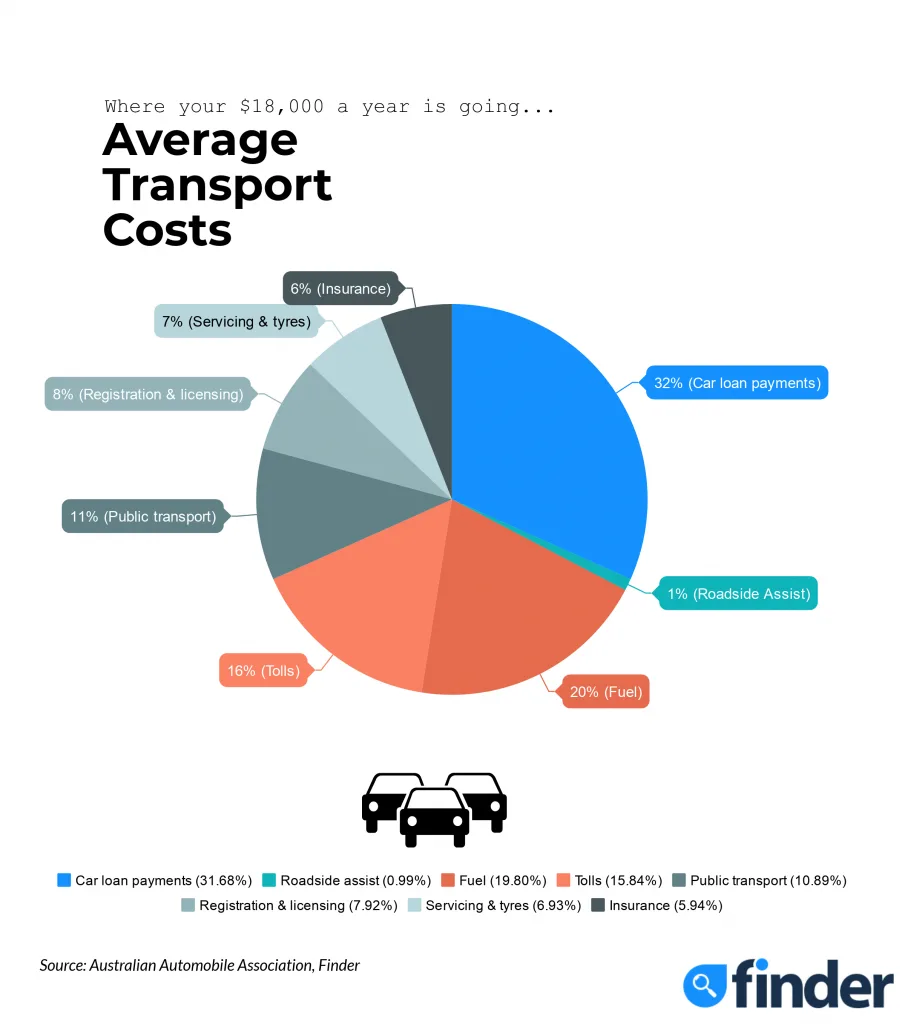- Bessie Hassan
- Head of PR & Money Expert
- finder.com.au
- +61 402 567 568
- Bessie.Hassan@finder.com.au
Media Release
Taken for a ride: Transport costs Australians $150 billion a year
- The typical household spends $1,500 a month on transport
- Car loans, fuel and tolls account for nearly 70% of costs
- Tips to reduce transport costs
11 April 2019, Sydney, Australia - Swapping the car for a bicycle could save Aussie households thousands every month, according to Finder, Australia's most visited comparison site.
The average Australian family spends $18,221 on transport costs in 12 months according to data released by the Australian Automobile Association (AAA)1. That's more than $1,500 a month.
A Finder analysis reveals this amounts to $150 billion spent on transport every year.
Kate Browne, Finder's personal finance expert, said ditching your car could be the key to reducing that burden.
"Carpooling, public transport, bike riding and walking are all cheaper options to running a motor vehicle, not to mention they are easier on the environment and better for traffic congestion.
"It could save you money and change your life," Browne said.
The proportion of total household income spent on transport is 14.4% for typical city households and 12.7% for regional households.
Browne said a huge chunk of a family's take-home pay is spent on just getting from A to B.
"Swapping the car for a bike is obviously not feasible for everyone. If you live in a public transport dead zone, or just really enjoy travelling in the comfort of your own car, there are other ways to reduce the cost.
"Avoid tolls, use a petrol price comparison app and review your comprehensive car insurance policy to make sure you're getting the best deal," Browne said.
The annual cost of transport increased more than $700 in the last 12 months.
The AAA research revealed last quarter's rise in transport costs was largely driven by repeated increases in fuel prices across all capital cities and regions.
"The weekly budget is getting stretched more and more, and some households are taking drastic measures to cut costs.
"A combination of taxi or Uber and car sharing services like GoGet could even work out cheaper for some when you consider fuel, insurance and registration costs," Browne said.
Car loans, fuel and tolls accounted for nearly 70% of these costs for the average driver.
Public transport, registration and licensing; servicing and tyres; insurance costs and roadside assistance round out the remaining 30%.
1https://www.aaa.asn.au/wp-content/uploads/2018/11/AAA-Affordability-Index-Q3-2018.pdf

Tips to reduce transport costs
- Shop around for cheaper car insurance: Comprehensive insurance premiums rose across the country. With around 50 policies available at Finder, find a better deal.
- Avoid tolls where possible: Tolls increased in Sydney, Melbourne and Brisbane in the 12 months to September 2018. Take an alternative route and save.
- Use a petrol price app: Compare prices of fuel in your local area to save up to 10c a litre.
- Ride a bike: Leave earlier and use pedal power to get you to where you need to go.
###
For further information
- Bessie Hassan
- Head of PR & Money Expert
- finder.com.au
- +61 402 567 568
- Bessie.Hassan@finder.com.au
Disclaimer
The information in this release is accurate as of the date published, but rates, fees and other product features may have changed. Please see updated product information on finder.com.au's review pages for the current correct values.
About Finder
Every month 2.6 million unique visitors turn to Finder to save money and time, and to make important life choices. We compare virtually everything from credit cards, phone plans, health insurance, travel deals and much more.
Our free service is 100% independently-owned by three Australians: Fred Schebesta, Frank Restuccia and Jeremy Cabral. Since launching in 2006, Finder has helped Aussies find what they need from 1,800+ brands across 100+ categories.
We continue to expand and launch around the globe, and now have offices in Australia, the United States, the United Kingdom, Canada, Poland and the Philippines. For further information visit www.finder.com.au.
12.6 million average unique monthly audience (June- September 2019), Nielsen Digital Panel